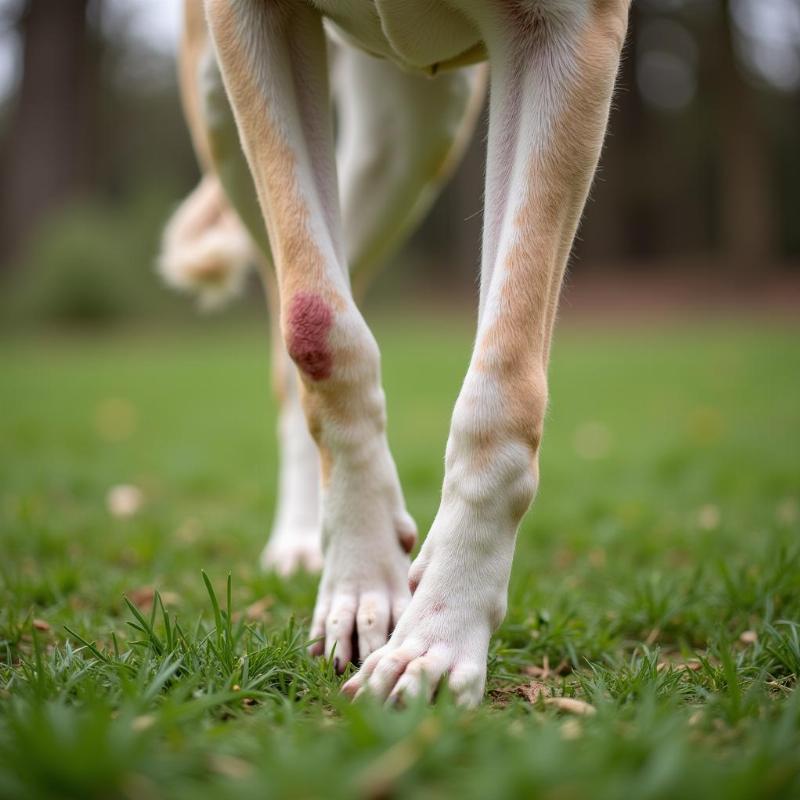If your dog is limping two years after TPLO (Tibial Plateau Leveling Osteotomy) surgery, you’re understandably concerned. While TPLO surgery is generally successful, complications or new injuries can arise. This article delves into potential reasons for post-TPLO limping, diagnostic approaches, treatment options, and preventive measures. We’ll cover everything from arthritis to infection, offering guidance and support for concerned dog owners.
Understanding Post-TPLO Limping
TPLO surgery aims to stabilize the knee joint by altering the angle of the tibial plateau. While highly effective, several factors can contribute to limping even years later. Identifying the underlying cause is crucial for effective management and ensuring your dog’s comfort. It’s important to remember that a limp can range from subtle to severe and can be intermittent or constant. Any change in your dog’s gait warrants veterinary attention.
 Dog Limping After TPLO Surgery
Dog Limping After TPLO Surgery
Possible Causes of Limping After TPLO Surgery
Several issues can contribute to limping years after TPLO surgery:
- Arthritis: Osteoarthritis is a common long-term complication of any knee injury, including those addressed by TPLO. The altered biomechanics, even with a successful surgery, can predispose the joint to wear and tear.
- Implant Complications: While rare, loosening or breakage of the implant can cause pain and instability, leading to limping.
- Infection: Though uncommon, infections can occur around the surgical site, even years later. Signs may include swelling, redness, warmth, and discharge, accompanied by limping.
- Soft Tissue Injuries: Ligament or meniscus injuries, either pre-existing or new, can contribute to pain and instability. The TPLO procedure primarily addresses bone issues, and soft tissue problems can persist or develop independently.
- Contralateral Limb Issues: Dogs who have undergone TPLO on one leg often put extra strain on the other leg, which can lead to injuries and subsequent limping.
- Referred Pain: Sometimes, pain from another area of the body, such as the hip or lower back, can manifest as limping in the leg that had TPLO surgery. This is known as referred pain.
Diagnosing the Cause of Limping
If your dog is limping two years after TPLO surgery, consult your veterinarian. They will likely recommend a combination of the following:
- Physical Examination: Assessing gait, range of motion, and palpating the leg for tenderness.
- Radiographs (X-rays): To evaluate the implant’s integrity, bone healing, and signs of arthritis.
- Advanced Imaging (CT or MRI): These can provide more detailed images of soft tissues, such as ligaments and meniscus, to identify subtle injuries.
- Joint Fluid Analysis: To assess for infection or inflammation within the joint.
Treatment Options for Post-TPLO Limping
Treatment will depend on the underlying cause of the limping:
- Arthritis Management: Pain medications, joint supplements, physical therapy, weight management, and other supportive care can help manage arthritis.
- Revision Surgery: In cases of implant failure or persistent instability, revision surgery might be necessary.
- Infection Treatment: Antibiotics and potentially surgical debridement are crucial for managing infections.
- Physical Therapy: Targeted exercises can improve strength, flexibility, and range of motion in the affected leg.
- Other Supportive Measures: These might include cold or heat therapy, acupuncture, laser therapy, or other modalities to manage pain and inflammation.
Preventing Post-TPLO Limping
While not all complications can be prevented, some strategies can help minimize the risk:
- Strict Adherence to Post-Operative Instructions: Following your veterinarian’s guidelines for rest, activity restriction, and physical therapy is crucial for proper healing and long-term joint health.
- Weight Management: Maintaining a healthy weight reduces stress on the joints and helps prevent arthritis.
- Regular Veterinary Check-ups: Routine examinations can help identify potential issues early on before they become significant problems.
- Controlled Exercise: Avoid excessive or high-impact activities that can strain the knee joint.
Conclusion
Limping two years after TPLO surgery can be concerning, but with proper diagnosis and treatment, many dogs can regain comfort and mobility. Don’t hesitate to contact your veterinarian if you notice any changes in your dog’s gait. Early intervention is key to successful management and ensuring your dog’s long-term well-being.
FAQ
- Is it normal for a dog to limp occasionally after TPLO surgery? While some occasional stiffness might be expected, persistent or worsening limping should be evaluated by a veterinarian.
- How long does it take for a dog to fully recover from TPLO surgery? Full recovery typically takes several months, with gradual improvement over time.
- What are the signs of infection after TPLO surgery? Signs of infection include swelling, redness, warmth, discharge, and increased pain around the surgical site.
- Can arthritis be prevented after TPLO surgery? While it can’t be entirely prevented, managing weight and providing appropriate exercise can help minimize the risk.
- What should I do if my dog starts limping again after TPLO surgery? Contact your veterinarian immediately for an evaluation.
- What are the alternatives to TPLO surgery for cruciate ligament injuries? Other surgical options include TTA (Tibial Tuberosity Advancement) and extracapsular repair.
- How much does TPLO surgery typically cost? The cost can vary depending on location and specific circumstances, but it generally ranges from $3,000 to $5,000.
About Beautdogs.us
Beautdogs.us is your premier online resource for comprehensive dog care information, breed-specific guidance, and expert advice on dog products and services in the USA. We cater to both new and experienced dog owners, offering valuable insights into canine health, nutrition, training, and overall well-being. As a trusted source for all things dog-related, we empower you to provide the best possible care for your beloved companion. Contact us today to learn more about our services and how we can help you navigate the joys and challenges of dog ownership. Email: [email protected], Phone: +1 501-555-7529.